For rug hooking, we need an open-weave fabric, and the best ones are linen, burlap and monk’s cloth.
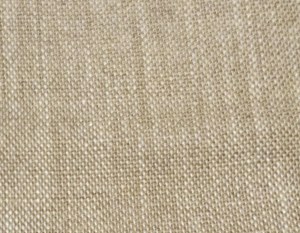
Linen is the most durable backing fabric you can use for rug hooking, and durability is a key component for making rugs that will last 100 years or more. Linen is made from the flax plant, and in order to be spun up, the plant must first be soaked in water to get rid of the outer plant material. What is left over, the part that has not rotted in the water, is what is spun into linen.
When we put rugs on the floor, we expect them to hold up to a good deal of wear and tear, and they will occasionally need to be washed. Linen is the best fiber because not only is it very strong, it is rot resistant, so it can get wet without degrading. If you want proof of linen’s extraordinary durability, you have only to look at the Bayeux Tapestry.
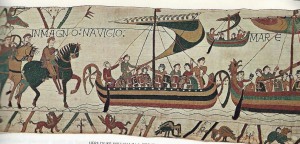
The Bayeux Tapestry (actually not a tapestry, it is an embroidery) is a very unique medieval textile made from wool yarn on linen fabric. It is amazing for many reasons. It is the only textile of its kind which tells, through embroidered cartoon, the story of the Norman Conquest of England in 1066 (or at least one side of the story). It measures approximately 270 feet long and around 20 inches high.
It is also a marvel because it has lasted over 900 years, and for most of those centuries, was not kept under ideal conditions. It has survived being stored in damp, dingy cellars, two world wars and the French Revolution, and countless fires and natural disasters. Now it is displayed in a museum in the city of Bayeux, France, where ordinary humans like you and me can view it up close and personal. It is one of the coolest things I have ever seen, and inspired me to make a few rug hooking designs (more about them in a later post).
The only reason the Bayeux Tapestry exists today is because it was embroidered on linen. If any of my hooked rugs last for 900 years, that would make me very, very happy.
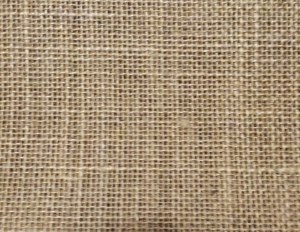
Burlap is a fabric that is very inexpensive and easy to find, so I use it in my beginner kits, as well as for small pillows, stuffed animals and other small ornaments that will not need to be washed. Burlap is made from the jute plant, which is wonderfully biodegradable. If you have ever purchased a shrub with the root ball wrapped in burlap, you don’t need to remove the burlap before planting it, because it will quickly deteriorate. So if I am making a project that is intended to go on the floor, I would use linen. If I am making a small wall hanging, I might use burlap, assuming that it will rarely, if ever need to be washed. However, if I am making a large wall hanging, I would still want linen because then I know the project will last.
There is a pretty big price difference between linen and burlap. Linen sells for $30-$35 per yard (or approximately $2 per square foot), whereas burlap sells for $4 per yard (around 44 cents per square foot). You can pay more for something called Scottish Burlap, but you are paying for a smoother fabric that is nicer to work with. Scottish Burlap is still made from jute, so it is prone to rot if it gets wet.
If you are anything like me, you would balk at spending $30 a yard for fabric, especially for fabric that won’t even be seen when the rug is finished! But linen is the only fabric that will ensure that my rug will be enjoyed for many generations to come. When you look at the cost per square foot for a hooked rug (mine start at $70 per square foot), and consider the cost of the yarn ($4-$20 per square foot of hooked area), the majority of the value of a hooked rug is by far the cost of my time and labor. I would spend exactly the same amount of time on a hooked rug that is made on burlap (saving myself $1.56 per square foot) but it would only last a fraction of the time, 20 years at best. So just trust me on this one, if you’re going to put the rug on the floor, it is penny wise but pound foolish to use burlap.
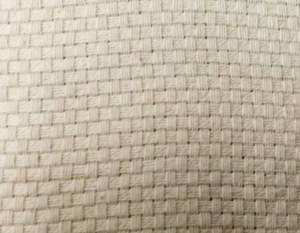
The third type of fabric that is commonly used in rug hooking is called Monk’s Cloth, which is made with cotton. Cotton is washable, so it is much better than burlap in that regard, but the fibers will become brittle with wear, so it’s not the most durable fabric you can use. And at around $15 per yard, it’s not that great of a bargain either. If you are bothered by working with burlap, and you are making something that won’t have to endure wear and tear, like a wall hanging, then Monk’s Cloth would work well for that.
I have been told that Monk’s Cloth is good for punch hooking. I can’t say with personal experience, since I don’t punch hook, but it may be preferred for punch hooking because it accommodates the punch tool better. In any event, I don’t use Monk’s Cloth because burlap and linen satisfy my needs.
Burlap and Monk’s Cloth can be purchased at your local fabric store, but linen is only sold by rug hooking companies (including Little House Rugs). As a special for my blog subscribers, you can order linen for 25% off for the month of March. Go to http://www.littlehouserugs.com/linen-blog-special.html to order.
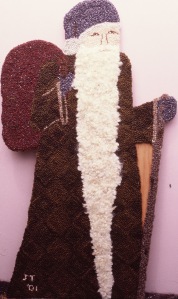
Remember that for every $50.00 you spend at Little House Rugs between now and November 25, 2015, you will be entered to win this hand-hooked Santa (a $165.00 value).
Have fun and happy hooking!
Judy Taylor
i am so interested in rug / wall hooking , i was wondering i have a linen panel curtain would that be ok to hook on ? got it at bed bath and beyond it’s a left over piece
thanks
LikeLike
Depending on how tight the weave, you may need to use a smaller hook, but otherwise, it should work great!
LikeLike
I have hooked a rug from a kit – a lion – for my granddaughter. The hooking has been finished for a year but I have not given it to her yet. I have no idea how to finish the back. I will get linen for the back. Could you give me advice as to how to find a video to show me such as on You Tube? Thank you.
LikeLike
You can watch my video on Youtube at https://www.youtube.com/watch?v=1WAqNkrDM5E&feature=youtu.be. I always recommend binding the edges rather than doing a simple folded-over hem, because you want to protect the backing along the edge (the first place to wear out on a hooked rug). I show this on my video, but I also have detailed instructions for finishing your rugs in my book, Joy of Hooking (With Yarn!), and you can check out my post https://judytaylor2013.wordpress.com/2015/04/02/getting-the-edges-right-hemming-your-masterpiece/
I’d love to see your lion rug when you get it finished. If you like, I can feature the rug on my website in the Featured Rug of the Month. If your rug is featured, you will receive a free half-yard of linen or our rug hooking bag that says “FIBER is good for you!”
LikeLike
Re: Burlap
Question about burlap weight best for rug hooking. Does it matter if it’s 8 oz or 10 oz?
LikeLike
Good question. The heavier weight backing will be more substantial to work with, but in either case, burlap is highly biodegradable, meaning it will fall apart with wear. I use burlap for wall hangings or stuffed animals, things that won’t be walked on. Linen and cotton (monk’s cloth and rug warp) are more durable and will last generations. They cost more, but the real cost of a rug isn’t the materials, it’s your time. You’ll spend exactly the same amount of time hooking a rug on linen, but it will last for 100 years or more!
LikeLike
Sure! Both as the thing you hook with, and the backing you hook through.
LikeLike
If you’re going to put a rug on the floor, I prefer linen. Most durable. If on the wall, your choice!
LikeLike